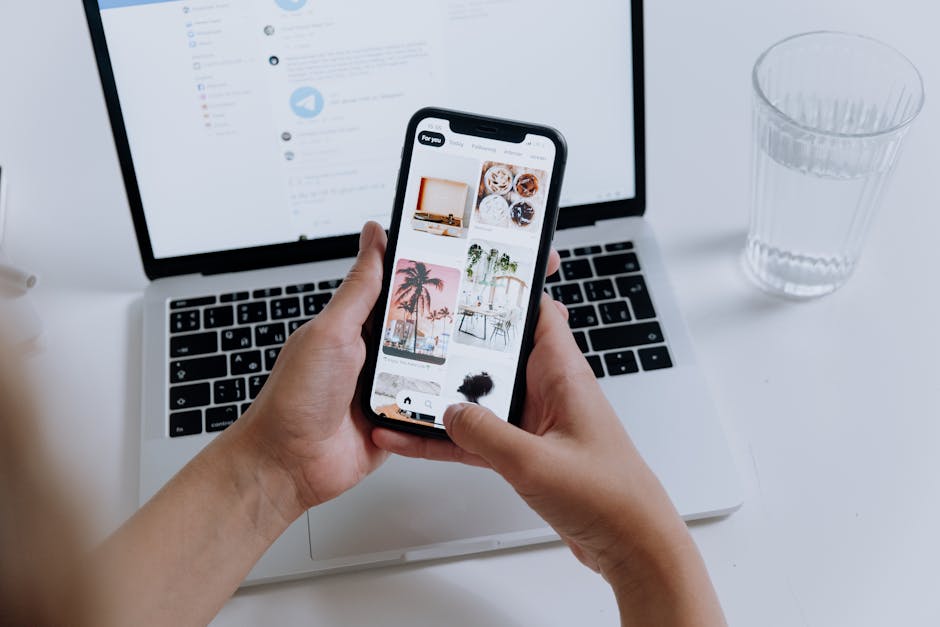
– Welcome to “The Journey”, today we’re gonna show you how to create images for your social media platforms. One of the easiest ways to improve consistency with branding is through, looking at all your social media platforms and making sure that they line up, with your voice, with your brand. And I was thinking a lot about, Instagram the other day and which brands I follow and actually how consistent are they? And I came across Jesse Kamm, if you can afford this clothing you’re doing something right in your world. But as you noticed on the Instagram, the consistency with the colors, the toning, the vibe from this California surf nature-Esq vibe there- – Yeah it’s like very natural, like in nature it’s that great style and great fashion of course.
– Yeah and actually… So, have you ever heard of this brand? – I have not.
– So this is…
Oh my God, this is perfect. ‘Cause I’ve stared at this purchased this, you’ve never looked at.
What do you notice that pops out as consistent? – It’s really the imagery that they use, looks like they’re trying to create just like fun, just kind of extreme ’cause they’re surfing, but also kind of serene too. Definitely beach ocean vibes there for sure. – [Emma] Yeah, very made in California- – [Nealey] And a surf board. – [Emma] Yeah, absolutely.
With the sunset and the beach, the surf boards, even this one, this is my favorite, the overalls and the girls on the bike and the skate. Taking from someone who’s never come across this brand and instantly there’s that imagery that, hey, this is consistent and there’s authenticity here because of that. – All right, so if you scroll down, I think the one that catches my eye is, the woman…
I think that’s Jesse actually surfing. I’m gonna click that open. – [Emma] That’s so rad. Yo babes I’m gonna ride these good vibes all the way to Fashion Week. This is original content.
This is great.
– [Nealey] This is it. – Yeah so…
Which is a good point because you… of course there’s stock photos out there, that you can grab and throw up on your Instagram. But what we recommend is, what can you create?
What can you do that’s original? Like this… Jesse Kamm, as Nealey pointed out when he first came across this brand, oh, this is very made in California, surf vibes, beach vibes.
And it’s so true to see even the owner out there, getting pitted on a surfboard, which lines up with the whole Instagram itself. And that again, it goes back to the authenticity there. – And I don’t think that you really need to go, like super high quality, high professional with some of these photos. Sometimes your brand’s voice is just being authentic and getting some pictures of you. Like I know if you scroll down a little bit, there’s one of her, it doesn’t look like super professional, but still surfing.
It’s just that content there that shows who she is. – Absolutely. And then even just with…
You think of a clothing brand, oh, I’m gonna do photos of clothes all the time, right? Whether it’s your customers wearing them or you’re wearing them or you just having them displayed, with like a simple light background, but there’s more to your brand than just the actual product. So, even like this post, well the surfing one was a good example, but even this post here, with all the fires that’s happening in Australia and just giving this point, this is a really eye catching photo and just, we were overcomed with sadness for our friends in Australia.
And then they’re donating 25% of every sale. So I think that’s important too.
Like while the image caught my eye, the caption is essential to, the writing is essential as well. There’s so much that goes into your actual feed as well as the profile photo. So in this case, it’s a little abstract for Jesse Kamm. Whereas, if you hop over to Modern Surfboards, they have their logo here. So, think about that for your brand.
What do you wanna do? Do you wanna represent your brand logo? Also brings up cover photos thinking about Facebook. That’s where you can also do a logo paired with maybe something more abstract, like you saw with the Instagram profile photo of Jesse Kamm. So, if I were a surfboard brand profile picture, I would do the logo cover photo.
I’d probably do a surfing photo, ’cause it’s such a great space to that. – And there’s lots of things you can do with the actual, cover itself. It doesn’t have to just be a photo, it’s prime real estate to add in other information that really shows your brand.
Actually you’re gonna do a demo of Canva and creating a Facebook header, a Twitter header and kind of see what we come up with. So inside of Canva under templates, just search cover, you can start just with Facebook covers and we’ll kind of go from there.
Now you can go and choose one of these templates that makes sense for your brand- – [Emma] Paradise awaits. – [Nealey] That’s it. Especially we’re gonna kind of make sure there’s- – [Emma] Are there any waves there? – [Nealey] We can update it. – [Emma] Okay.
– The thing not to get hung up with, when choosing one of these templates is, don’t get hung up on the imagery and some of the verbiage itself, find one that really fits your brand. ‘Cause we can change that pretty easily. And we’ll show you here. So is that the one? – [Emma] Yes.
– [Nealey] All right.
– [Emma] I love these colors. – [Nealey] Use this template. – [Emma] Got it. – [Nealey] All right, so, inside here, if you ever change your mind templates will pop right up on the left hand side.
She can quickly change it. It’s like… Go ahead and click any of them.
– [Emma] I may be selective here. – [Nealey] We’re gonna undo it. So this is fine- – [Emma] Ooh, that’s cool. – [Nealey] That’s kind of cool. – [Emma] Wait, I wanna go with this one now.
– [Nealey] This is the one? – [Emma] Yeah, that’s the one. Actually hold on. Yeah, that’s the one, okay. – [Nealey] That’s the one?
All right. So, we’ve changed our mind. We’ve picked a different template. So, now it’s time..
. Let’s kind of adjust a little bit. I think we can really go with some type of beach vibe, in some of these letters. Is pink your color though, for your brand? – [Emma] Was thinking.
.. Yeah, this is not real. (Emma laughing) I was picturing more of the blues. That’s why I was drawn to the first cover image, ’cause there was a variety of blues so- – [Nealey] Go ahead and click the background.
– [Emma] Okay. – [Nealey] And then click the pink in the top left. – [Emma] This is so user-friendly. – [Nealey] I know right? – [Emma] Shout out Canva.
– [Nealey] Go ahead and choose that little rainbow wheel color at the very top left. I’ll let you go ahead and just choose what color makes- – [Emma] Oh, I like some of these that are already there. – [Nealey] Okay, you can pick them. – [Emma] Yeah. – [Nealey] Those won’t show up for everyone.
I use Canva pretty religiously so I have templates- – [Emma] Oh, they know. – [Nealey] As you know, if you’ve ever watched any of these videos, Canva shout out, but go ahead and choose what color makes sense. – [Emma] Okay, so I like this blue for the background. – [Nealey] Cool. Now we want to probably change the pink background as well, right?
– [Emma] Well, it kind of matches my shirt. – [Nealey] All right, let’s keep them.
– [Emma] Let’s keep it. – [Nealey] So, this template has overlays of these letters. Let’s do a couple of them with waves since that really is you and your fake real brand- – [Emma] It feels real.
– [Nealey] Choose photos on the left-hand side. – [Emma] Okay. – [Nealey] And then just search, “surf”. – [Emma] Should I surf it or search it? – [Nealey] You should both it.
Now, this is great. Welcome to the Canva Design Circle, the greatest design community on Facebook! My name is Ed, I’m from Sydney Australia, and I’m the Community Manager here. It’s great to meet you.
I’ve put together a few useful posts/tips for you to get you started on the right foot! Read on…
Tutorial: In this tutorial, I will show you how to use Canva to create an invoice (both printable and digital) that you can use when billing clients! Canva makes it easier than ever with templates. Watch now: https://bit.ly/3J6PS39
Free Design Workshops: We have a tonne of FREE DESIGN WORKSHOPS in December/Jan designed to help you take your general design skills, knowledge of Canva, branding, and business skills to the next level! Register your interest here (https://bit.ly/3lFYm6l) to attend or receive links to watch them!
** Learn how to use Canva: **We’ve organized dozens of Playlists on our YouTube Channel with tutorials and webinars sorted by themes to make it easy for you. Start here: https://bit.ly/YTCanvaDirectSub
FAQs: Here is a link to a Community document with some frequently asked questions we receive in this group. You might find a lot of this info super useful! Link: https://bit.ly/3xynVe4
All right, we’ll do this on the A- – And then go filter again and then get rid of that gray filter that it has with the template.
You have the Facebook header and brand consistency is pretty important, right? – Yes. – So if you this across your other social media platforms like LinkedIn or Twitter, there’s different sizes to this.
It’s not one size fits all. This might look great on Facebook, but it might be cutoff on Twitter and vice versa. So, on Canva, you can go ahead and choose resize and kind of see the different options. So I obviously use this a lot. So it shows recent Twitter header.
And you can see that a Twitter header is 1500 pixels wide by 500 pixels tall or height. So, I can go and choose that I can copy and resize, click that button right there. Then I have one directly for Twitter and it made it a little bit longer than the Facebook one. And then vice versa if I have any other cover photos or sizes that I might want as a brand. Because again, that consistency is important to really be the same across the board.
So if someone finds you on Instagram, are they gonna have the same experience with your brand on Twitter? Or are they gonna be like, well, what is this brand really? – [Emma] I have an example. – [Nealey] Let’s see it. – [Emma] Okay, so, I was checking out, Global Surf Industries and I found them on Twitter.
First of all, speaking of headers, do you think they sized that with Canva? – [Nealey] Maybe, I don’t know. I’m not a doctor. – [Emma] So, looks good the images there, also, you notice their logo here on Twitter. So, being curious about consistency and branding since we talk about all the time, I naturally hopped over to their Facebook page.
So, here’s their Facebook. Again, they have their logo as a profile photo- – [Nealey] And the same slogan there. Life is better when you surf. Different image- – [Emma] Different image, but exactly same slogan.
Now, let’s see if they have all three bada bing bada boom, same logo on the Instagram.
And what do you notice in the bio? – [Nealey] Same slogan. – [Emma] Life is better when you surf. So consistency across each of the platforms, Twitter, Facebook and Instagram. – Now all this consistency is super important.
And these social media profiles have different dimensions with their headers, their logos, their images, the little post that shared… The little image that shares when you share a link. There’s a couple of different ways you can essentially resize them.
So, with your actual blog posts, you usually have a featured image. And that’s the one that pops up when you share that profile.
I know if you’re using WordPress, they’re popular plugins like Yoast SEO, they’ll actually help you set up and add different images per the different platforms like Facebook or Twitter or LinkedIn. So when you share, it’s gonna pull from that image first and again, they have different dimensions. We’ll have descriptions down below, with some of the information on what it is.
But again, Canva is your friend. You can go ahead and resize to be whatever fits your dimension for whatever post it is. So if it’s gonna be a Twitter post- – [Emma] You think I made it? – [Nealey] Sure, that’s probably easier than me leaning right over.
I’ll let you drive, so you’re gonna do Twitter post- – [Emma] All right, get in the passenger seat.
All right, what? – [Nealey] Twitter posts right there, copy and resize. And then when you would use this and upload it to your website, if you’re using WordPress there’s other ways to do it, but it’s a bit more complex but that way it’s gonna show this post on Twitter. And then if you have one that’s gonna show on Facebook, you can set it up so it’s gonna show the Facebook dimension sizes.
So it all looks exactly like you want it to.
– All right, now I have all my images, there resized for the appropriate platforms. Now what do I do? – So this is gonna be kind of a little, out of left field when it comes to social media profile, like profile photos and headers and all these different things. But there are some things like metadata that you’ll also want to take into account. These are things like alt tags and titles and descriptions for your images.
This more so applies for websites. It’s basically how Google sees those images. So, when it crawls it, can’t see this beautiful vacay photo and only sees a bunch of random lines of code, that alt texts definitely helps understand like, cool, what is this photo all about? To where if someone’s searching online, they might find it.
– Can I guess, what would be good?
– Sure. – So, thinking about this image and to, capture the right audience as well as what we’re capturing as a brand in this surf, surfer beach, palm trees, waves, is that… – Yeah and it’s that alt text, you’re just trying to describe that image.
– And then by doing that, how would that help the image? I guess that’s where I’m a little confused. – So that’s on the website itself primarily, Instagram does have an alt tag option now, after you post and go back in and actually add alt tags to your images- – Sweet I’m glad that, that’s an option. That’s really cool. I did not know that.
All right, that’s our app. You just learned how to create images for your social media platforms. Be sure to like this video, add your comments below- – Subscribe to our channel and ring that bell to get these episodes first, this is “The Journey.” We’ll see you next time.





